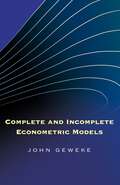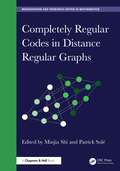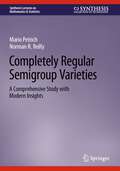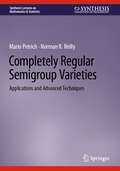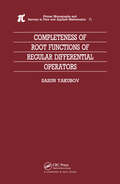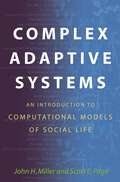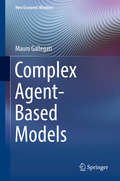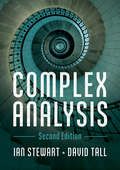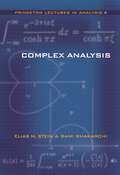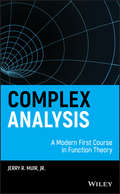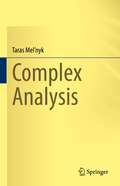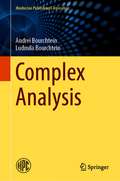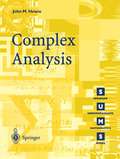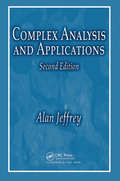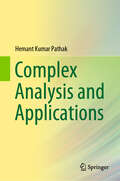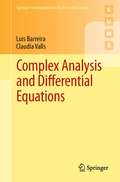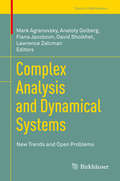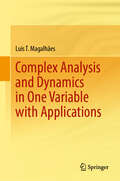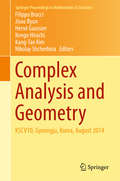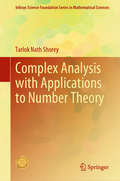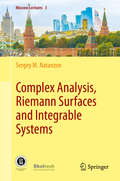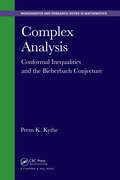- Table View
- List View
Complete and Incomplete Econometric Models (The Econometric and Tinbergen Institutes Lectures)
by John GewekeEconometric models are widely used in the creation and evaluation of economic policy in the public and private sectors. But these models are useful only if they adequately account for the phenomena in question, and they can be quite misleading if they do not. In response, econometricians have developed tests and other checks for model adequacy. All of these methods, however, take as given the specification of the model to be tested. In this book, John Geweke addresses the critical earlier stage of model development, the point at which potential models are inherently incomplete. Summarizing and extending recent advances in Bayesian econometrics, Geweke shows how simple modern simulation methods can complement the creative process of model formulation. These methods, which are accessible to economics PhD students as well as to practicing applied econometricians, streamline the processes of model development and specification checking. Complete with illustrations from a wide variety of applications, this is an important contribution to econometrics that will interest economists and PhD students alike.
Completely Regular Codes in Distance Regular Graphs (Chapman & Hall/CRC Monographs and Research Notes in Mathematics)
by Patrick Solé Minjia ShiThe concept of completely regular codes was introduced by Delsarte in his celebrated 1973 thesis, which created the field of Algebraic Combinatorics. This notion was extended by several authors from classical codes over finite fields to codes in distance-regular graphs. Half a century later, there was no book dedicated uniquely to this notion. Most of Delsarte examples were in the Hamming and Johnson graphs. In recent years, many examples were constructed in other distance regular graphs including q-analogues of the previous, and the Doob graph.Completely Regular Codes in Distance Regular Graphs provides, for the first time, a definitive source for the main theoretical notions underpinning this fascinating area of study. It also supplies several useful surveys of constructions using coding theory, design theory and finite geometry in the various families of distance regular graphs of large diameters. Features Written by pioneering experts in the domain Suitable as a research reference at the master’s level Includes extensive tables of completely regular codes in the Hamming graph Features a collection of up-to-date surveys.
Completely Regular Semigroup Varieties: A Comprehensive Study with Modern Insights (Synthesis Lectures on Mathematics & Statistics)
by Mario Petrich Norman R. ReillyThis book is a unified treatment of the most important core developments in the theory of completely regular semigroup theory as it stands today. This volume focuses on the lattice of varieties of completely regular semigroups. Since any in-depth study of the lattice of varieties requires an understanding of free completely regular semigroups, the book begins by describing the free object on countably infinite sets and the properties of the lattice of fully invariant congruences on the free object. The authors introduce various associated relations and operators on the lattice of varieties of completely regular semigroups. Following that, the book covers the sublattice of varieties of bands with a focus on the influence of that sublattice on the structure of the whole lattice. The book concludes with the remarkable theorem due to Polák describing the whole lattice of varieties of completely regular as a subdirect product of lattices,some of which are well understood. The authors include recent advances, insights, results, and techniques throughout the book.
Completely Regular Semigroup Varieties: Applications and Advanced Techniques (Synthesis Lectures on Mathematics & Statistics)
by Mario Petrich Norman R. ReillyThis book presents further developments and applications in the area of completely regular semigroup theory, beginning with applications of Polák’s theorem to obtain detailed descriptions of various kernel classes including the K-class covers of the kernel class of all bands. The important property of modularity of the lattice of varieties of completely regular semigroups is then employed to analyse various principal sublattices. This is followed by a study of certain important complete congruences on the lattice; the group, local and core relations. The next chapter is devoted to a further treatment of certain free objects and related word problems. There are many constructions in the theory of semigroups. Those that have played an important role in the theory of varieties of completely regular semigroups are presented as they apply in this context. The mapping that takes each variety to its intersection with the variety of bands is a complete retraction of the lattice of varieties of completely regular semigroups onto the lattice of band varieties and so induces a complete congruence for which every class has a greatest member. The sublattice generated by these greatest members is then investigated with the help of many applications of Polák’s theorem. The book closes with a fascinating conjecture regarding the structure of this sublattice.
Completeness of Root Functions of Regular Differential Operators (Monographs And Surveys In Pure And Applied Mathematics Ser. #71)
by Sasun YakubovThe precise mathematical investigation of various natural phenomena is an old and difficult problem. This book is the first to deal systematically with the general non-selfadjoint problems in mechanics and physics. It deals mainly with bounded domains with smooth boundaries, but also considers elliptic boundary value problems in tube domains, i.e. in non-smooth domains. This volume will be of particular value to those working in differential equations, functional analysis, and equations of mathematical physics.
Completion, Čech and Local Homology and Cohomology: Interactions Between Them (Springer Monographs in Mathematics)
by Peter Schenzel Anne-Marie SimonThe aim of the present monograph is a thorough study of the adic-completion, its left derived functors and their relations to the local cohomology functors, as well as several completeness criteria, related questions and various dualities formulas. A basic construction is the Čech complex with respect to a system of elements and its free resolution. The study of its homology and cohomology will play a crucial role in order to understand left derived functors of completion and right derived functors of torsion. This is useful for the extension and refinement of results known for modules to unbounded complexes in the more general setting of not necessarily Noetherian rings.The book is divided into three parts. The first one is devoted to modules, where the adic-completion functor is presented in full details with generalizations of some previous completeness criteria for modules. Part II is devoted to the study of complexes. Part III is mainly concerned with duality, starting with those between completion and torsion and leading to new aspects of various dualizing complexes.The Appendix covers various additional and complementary aspects of the previous investigations and also provides examples showing the necessity of the assumptions. The book is directed to readers interested in recent progress in Homological and Commutative Algebra. Necessary prerequisites include some knowledge of Commutative Algebra and a familiarity with basic Homological Algebra. The book could be used as base for seminars with graduate students interested in Homological Algebra with a view towards recent research.
Completion, Čech and Local Homology and Cohomology: Interactions Between Them (Springer Monographs in Mathematics)
by Peter Schenzel Anne-Marie SimonThe aim of the present monograph is a thorough study of the adic-completion, its left derived functors and their relations to the local cohomology functors, as well as several completeness criteria, related questions and various dualities formulas. A basic construction is the Čech complex with respect to a system of elements and its free resolution. The study of its homology and cohomology will play a crucial role in order to understand left derived functors of completion and right derived functors of torsion. This is useful for the extension and refinement of results known for modules to unbounded complexes in the more general setting of not necessarily Noetherian rings.The book is divided into three parts. The first one is devoted to modules, where the adic-completion functor is presented in full details with generalizations of some previous completeness criteria for modules. Part II is devoted to the study of complexes. Part III is mainly concerned with duality, starting with those between completion and torsion and leading to new aspects of various dualizing complexes.The Appendix covers various additional and complementary aspects of the previous investigations and also provides examples showing the necessity of the assumptions. The book is directed to readers interested in recent progress in Homological and Commutative Algebra. Necessary prerequisites include some knowledge of Commutative Algebra and a familiarity with basic Homological Algebra. The book could be used as base for seminars with graduate students interested in Homological Algebra with a view towards recent research.
Complex Adaptive Systems: An Introduction to Computational Models of Social Life (Princeton Studies in Complexity #14)
by John H. Miller Scott PageThis book provides the first clear, comprehensive, and accessible account of complex adaptive social systems, by two of the field's leading authorities. Such systems--whether political parties, stock markets, or ant colonies--present some of the most intriguing theoretical and practical challenges confronting the social sciences. Engagingly written, and balancing technical detail with intuitive explanations, Complex Adaptive Systems focuses on the key tools and ideas that have emerged in the field since the mid-1990s, as well as the techniques needed to investigate such systems. It provides a detailed introduction to concepts such as emergence, self-organized criticality, automata, networks, diversity, adaptation, and feedback. It also demonstrates how complex adaptive systems can be explored using methods ranging from mathematics to computational models of adaptive agents. John Miller and Scott Page show how to combine ideas from economics, political science, biology, physics, and computer science to illuminate topics in organization, adaptation, decentralization, and robustness. They also demonstrate how the usual extremes used in modeling can be fruitfully transcended.
Complex Agent-Based Models (New Economic Windows)
by Mauro GallegatiThis book offers a thorough introduction to the highly promising complex agent-based approach to economics, in which agent-based models (ABMs) are used to represent economic systems as complex and evolving systems composed of heterogeneous agents of limited rationality who interact with each other, generating the system’s emergent properties in the process. This approach represents a response to the limitations of the dominant theory in economics, which does not consider the possibility of a major crisis, and to the inability of dynamic stochastic general equilibrium theory to generate empirically falsifiable propositions. In the new perspective, the focus is on identifying the elements of instability rather than the triggering event. As the theory of complexity demonstrates, the interactions of heterogeneous agents produce non-linearity: this puts an end to the age of certainties. With ABMs, the methodology is “from the bottom up”. The individual parameters and their distribution are estimated, and then evaluated to verify whether aggregate regularities emerge on the whole. In short, not only micro, but also meso and macro empirical validation are employed. Moreover, it shows that the mantra of growth should be supplanted by the concept of a growth. Given its depth of coverage, the book will enable students at the undergraduate and Master’s level to gain a firm grasp of this important emerging approach. “This book is flower blossomed by one of the two greatest Italian economists.” Bruce Greenwald, Columbia University “The author’s - the ABM prophet’s - thoughts on economics have been at the forefront of the world. Without a firm belief in and dedication to human society, it is impossible to write such a book. This is a work of high academic value, which can help readers quickly understand the history and current situation of complex economic theory. In particular, we can understand the basic viewpoints, academic status, advantages and shortcomings of various schools of economic theory.” Jie Wu, Guangzhou Milestone Software Co., China
Complex Analysis
by Ian Stewart David TallThis new edition of a classic textbook develops complex analysis from the established theory of real analysis by emphasising the differences that arise as a result of the richer geometry of the complex plane. Key features of the authors' approach are to use simple topological ideas to translate visual intuition to rigorous proof, and, in this edition, to address the conceptual conflicts between pure and applied approaches head-on. Beyond the material of the clarified and corrected original edition, there are three new chapters: Chapter 15, on infinitesimals in real and complex analysis; Chapter 16, on homology versions of Cauchy's theorem and Cauchy's residue theorem, linking back to geometric intuition; and Chapter 17, outlines some more advanced directions in which complex analysis has developed, and continues to evolve into the future. With numerous worked examples and exercises, clear and direct proofs, and a view to the future of the subject, this is an invaluable companion for any modern complex analysis course.
Complex Analysis
by Elias M. Stein Rami ShakarchiWith this second volume, we enter the intriguing world of complex analysis. From the first theorems on, the elegance and sweep of the results is evident. The starting point is the simple idea of extending a function initially given for real values of the argument to one that is defined when the argument is complex. From there, one proceeds to the main properties of holomorphic functions, whose proofs are generally short and quite illuminating: the Cauchy theorems, residues, analytic continuation, the argument principle. With this background, the reader is ready to learn a wealth of additional material connecting the subject with other areas of mathematics: the Fourier transform treated by contour integration, the zeta function and the prime number theorem, and an introduction to elliptic functions culminating in their application to combinatorics and number theory. Thoroughly developing a subject with many ramifications, while striking a careful balance between conceptual insights and the technical underpinnings of rigorous analysis, Complex Analysis will be welcomed by students of mathematics, physics, engineering and other sciences. The Princeton Lectures in Analysis represents a sustained effort to introduce the core areas of mathematical analysis while also illustrating the organic unity between them. Numerous examples and applications throughout its four planned volumes, of which Complex Analysis is the second, highlight the far-reaching consequences of certain ideas in analysis to other fields of mathematics and a variety of sciences. Stein and Shakarchi move from an introduction addressing Fourier series and integrals to in-depth considerations of complex analysis; measure and integration theory, and Hilbert spaces; and, finally, further topics such as functional analysis, distributions and elements of probability theory.
Complex Analysis
by Jerry R. MuirA thorough introduction to the theory of complex functions emphasizing the beauty, power, and counterintuitive nature of the subject Written with a reader-friendly approach, Complex Analysis: A Modern First Course in Function Theory features a self-contained, concise development of the fundamental principles of complex analysis. After laying groundwork on complex numbers and the calculus and geometric mapping properties of functions of a complex variable, the author uses power series as a unifying theme to define and study the many rich and occasionally surprising properties of analytic functions, including the Cauchy theory and residue theorem. The book concludes with a treatment of harmonic functions and an epilogue on the Riemann mapping theorem. Thoroughly classroom tested at multiple universities, Complex Analysis: A Modern First Course in Function Theory features: Plentiful exercises, both computational and theoretical, of varying levels of difficulty, including several that could be used for student projects Numerous figures to illustrate geometric concepts and constructions used in proofs Remarks at the conclusion of each section that place the main concepts in context, compare and contrast results with the calculus of real functions, and provide historical notes Appendices on the basics of sets and functions and a handful of useful results from advanced calculus Appropriate for students majoring in pure or applied mathematics as well as physics or engineering, Complex Analysis: A Modern First Course in Function Theory is an ideal textbook for a one-semester course in complex analysis for those with a strong foundation in multivariable calculus. The logically complete book also serves as a key reference for mathematicians, physicists, and engineers and is an excellent source for anyone interested in independently learning or reviewing the beautiful subject of complex analysis.
Complex Analysis
by Taras Mel'nykToday, the theory of complex-valued functions finds widespread applications in various areas of mathematical research, as well as in electrical and mechanical engineering, aeronautics, and other disciplines. Complex analysis has become a basic course in mathematics, physics, and select engineering departments.This concise textbook provides a thorough introduction to the function theory of one complex variable. It presents the fundamental concepts with clarity and rigor, offering concise proofs that avoid lengthy and tedious arguments commonly found in mathematics textbooks. It goes beyond traditional texts by exploring less common topics, including the different approaches to constructing analytic functions, the conformal mapping criterion, integration of analytic functions along arbitrary curves, global analytic functions and their Riemann surfaces, the general inverse function theorem, the Lagrange–Bürmann formula, and Puiseux series.Drawing from several decades of teaching experience, this book is ideally suited for one or two semester courses in complex analysis. It also serves as a valuable companion for courses in topology, approximation theory, asymptotic analysis, and functional analysis. Abundant examples and exercises make it suitable for self-study as well.
Complex Analysis (Hindustan Publishing Corporation)
by Andrei Bourchtein Ludmila BourchteinThis book discusses all the major topics of complex analysis, beginning with the properties of complex numbers and ending with the proofs of the fundamental principles of conformal mappings. Topics covered in the book include the study of holomorphic and analytic functions, classification of singular points and the Laurent series expansion, theory of residues and their application to evaluation of integrals, systematic study of elementary functions, analysis of conformal mappings and their applications—making this book self-sufficient and the reader independent of any other texts on complex variables. The book is aimed at the advanced undergraduate students of mathematics and engineering, as well as those interested in studying complex analysis with a good working knowledge of advanced calculus. The mathematical level of the exposition corresponds to advanced undergraduate courses of mathematical analysis and first graduate introduction to the discipline. The book contains a large number of problems and exercises, making it suitable for both classroom use and self-study. Many standard exercises are included in each section to develop basic skills and test the understanding of concepts. Other problems are more theoretically oriented and illustrate intricate points of the theory. Many additional problems are proposed as homework tasks whose level ranges from straightforward, but not overly simple, exercises to problems of considerable difficulty but of comparable interest.
Complex Analysis (Springer Undergraduate Mathematics Series)
by John M. HowieComplex analysis can be a difficult subject and many introductory texts are just too ambitious for today’s students. This book takes a lower starting point than is traditional and concentrates on explaining the key ideas through worked examples and informal explanations, rather than through "dry" theory.
Complex Analysis and Applications
by Alan JeffreyComplex Analysis and Applications, Second Edition explains complex analysis for students of applied mathematics and engineering. Restructured and completely revised, this textbook first develops the theory of complex analysis, and then examines its geometrical interpretation and application to Dirichlet and Neumann boundary value problems.
Complex Analysis and Applications
by Hemant Kumar PathakThis book offers an essential textbook on complex analysis. After introducing the theory of complex analysis, it places special emphasis on the importance of Poincare theorem and Hartog’s theorem in the function theory of several complex variables. Further, it lays the groundwork for future study in analysis, linear algebra, numerical analysis, geometry, number theory, physics (including hydrodynamics and thermodynamics), and electrical engineering. To benefit most from the book, students should have some prior knowledge of complex numbers. However, the essential prerequisites are quite minimal, and include basic calculus with some knowledge of partial derivatives, definite integrals, and topics in advanced calculus such as Leibniz’s rule for differentiating under the integral sign and to some extent analysis of infinite series. The book offers a valuable asset for undergraduate and graduate students of mathematics and engineering, as well as students with no background in topological properties.
Complex Analysis and Differential Equations (Springer Undergraduate Mathematics Series)
by Luis Barreira Claudia VallsThis text provides an accessible, self-contained and rigorous introduction to complex analysis and differential equations. Topics covered include holomorphic functions, Fourier series, ordinary and partial differential equations. The text is divided into two parts: part one focuses on complex analysis and part two on differential equations. Each part can be read independently, so in essence this text offers two books in one. In the second part of the book, some emphasis is given to the application of complex analysis to differential equations. Half of the book consists of approximately 200 worked out problems, carefully prepared for each part of theory, plus 200 exercises of variable levels of difficulty. Tailored to any course giving the first introduction to complex analysis or differential equations, this text assumes only a basic knowledge of linear algebra and differential and integral calculus. Moreover, the large number of examples, worked out problems and exercises makes this the ideal book for independent study.
Complex Analysis and Dynamical Systems: New Trends and Open Problems (Trends in Mathematics #553)
by Lawrence Zalcman Mark Agranovsky Anatoly Golberg Fiana Jacobzon David ShoikhetThis book focuses on developments in complex dynamical systems and geometric function theory over the past decade, showing strong links with other areas of mathematics and the natural sciences. Traditional methods and approaches surface in physics and in the life and engineering sciences with increasing frequency - the Schramm‐Loewner evolution, Laplacian growth, and quadratic differentials are just a few typical examples. This book provides a representative overview of these processes and collects open problems in the various areas, while at the same time showing where and how each particular topic evolves. This volume is dedicated to the memory of Alexander Vasiliev.
Complex Analysis and Dynamics in One Variable with Applications
by Luis T. MagalhãesThis textbook has been designed to support the initial study of Complex Analysis, progressing to Complex Dynamics. It focuses on the fundamental aspects of one-variable complex functions, covering the geometric theory and dynamics of iterations of rational mappings. Following the standard material, the book delves into an extensive range of advanced topics, encompassing the requirements for a one-year graduate-level course or a preliminary exam. In this work, the reader will discover three distinctive characteristics: it simplifies and unifies ideas and concepts that might appear disparate or complicated in real analysis; it contributes to the development of other areas in mathematics; and it showcases relevance for applications in Science and Engineering, with many exercises. Historical notes throughout the text help to contextualize the theory. With its flexible structure, this textbook provides a solid foundation for a first course in Complex Analysis and for a second more advanced course, establishing a robust basis for subsequent studies.
Complex Analysis and Geometry: KSCV10, Gyeongju, Korea, August 2014 (Springer Proceedings in Mathematics & Statistics #144)
by Filippo Bracci Jisoo Byun Hervé Gaussier Kengo Hirachi Kang-Tae Kim Nikolay ShcherbinaThis volume includes 28 chapters by authors who are leading researchers of the world describing many of the up-to-date aspects in the field of several complex variables (SCV). These contributions are based upon their presentations at the 10th Korean Conference on Several Complex Variables (KSCV10), held as a satellite conference to the International Congress of Mathematicians (ICM) 2014 in Seoul, Korea. SCV has been the term for multidimensional complex analysis, one of the central research areas in mathematics. Studies over time have revealed a variety of rich, intriguing, new knowledge in complex analysis and geometry of analytic spaces and holomorphic functions which were "hidden" in the case of complex dimension one. These new theories have significant intersections with algebraic geometry, differential geometry, partial differential equations, dynamics, functional analysis and operator theory, and sheaves and cohomology, as well as the traditional analysis of holomorphic functions in all dimensions. This book is suitable for a broad audience of mathematicians at and above the beginning graduate-student level. Many chapters pose open-ended problems for further research, and one in particular is devoted to problems for future investigations.
Complex Analysis with Applications to Flows and Fields (Mathematics and Physics for Science and Technology)
by Luis Manuel Braga da Costa CamposComplex Analysis with Applications to Flows and Fields presents the theory of functions of a complex variable, from the complex plane to the calculus of residues to power series to conformal mapping. The book explores numerous physical and engineering applications concerning potential flows, the gravity field, electro- and magnetostatics, steady he
Complex Analysis with Applications to Number Theory (Infosys Science Foundation Series)
by Tarlok Nath ShoreyThe book discusses major topics in complex analysis with applications to number theory. This book is intended as a text for graduate students of mathematics and undergraduate students of engineering, as well as to researchers in complex analysis and number theory. This theory is a prerequisite for the study of many areas of mathematics, including the theory of several finitely and infinitely many complex variables, hyperbolic geometry, two and three manifolds and number theory. In additional to solved examples and problems, the book covers most of the topics of current interest, such as Cauchy theorems, Picard’s theorems, Riemann–Zeta function, Dirichlet theorem, gamma function and harmonic functions.
Complex Analysis, Riemann Surfaces and Integrable Systems (Moscow Lectures #3)
by Sergey M. NatanzonThis book is devoted to classical and modern achievements in complex analysis. In order to benefit most from it, a first-year university background is sufficient; all other statements and proofs are provided. We begin with a brief but fairly complete course on the theory of holomorphic, meromorphic, and harmonic functions. We then present a uniformization theory, and discuss a representation of the moduli space of Riemann surfaces of a fixed topological type as a factor space of a contracted space by a discrete group. Next, we consider compact Riemann surfaces and prove the classical theorems of Riemann-Roch, Abel, Weierstrass, etc. We also construct theta functions that are very important for a range of applications. After that, we turn to modern applications of this theory. First, we build the (important for mathematics and mathematical physics) Kadomtsev-Petviashvili hierarchy and use validated results to arrive at important solutions to these differential equations. We subsequently use the theory of harmonic functions and the theory of differential hierarchies to explicitly construct a conformal mapping that translates an arbitrary contractible domain into a standard disk – a classical problem that has important applications in hydrodynamics, gas dynamics, etc. The book is based on numerous lecture courses given by the author at the Independent University of Moscow and at the Mathematics Department of the Higher School of Economics.
Complex Analysis: Conformal Inequalities and the Bieberbach Conjecture
by Prem K. KytheComplex Analysis: Conformal Inequalities and the Bieberbach Conjecture discusses the mathematical analysis created around the Bieberbach conjecture, which is responsible for the development of many beautiful aspects of complex analysis, especially in the geometric-function theory of univalent functions. Assuming basic knowledge of complex analysis
